Ziyi Kou
UGMAE: A Unified Framework for Graph Masked Autoencoders
Feb 12, 2024



Abstract:Generative self-supervised learning on graphs, particularly graph masked autoencoders, has emerged as a popular learning paradigm and demonstrated its efficacy in handling non-Euclidean data. However, several remaining issues limit the capability of existing methods: 1) the disregard of uneven node significance in masking, 2) the underutilization of holistic graph information, 3) the ignorance of semantic knowledge in the representation space due to the exclusive use of reconstruction loss in the output space, and 4) the unstable reconstructions caused by the large volume of masked contents. In light of this, we propose UGMAE, a unified framework for graph masked autoencoders to address these issues from the perspectives of adaptivity, integrity, complementarity, and consistency. Specifically, we first develop an adaptive feature mask generator to account for the unique significance of nodes and sample informative masks (adaptivity). We then design a ranking-based structure reconstruction objective joint with feature reconstruction to capture holistic graph information and emphasize the topological proximity between neighbors (integrity). After that, we present a bootstrapping-based similarity module to encode the high-level semantic knowledge in the representation space, complementary to the low-level reconstruction in the output space (complementarity). Finally, we build a consistency assurance module to provide reconstruction objectives with extra stabilized consistency targets (consistency). Extensive experiments demonstrate that UGMAE outperforms both contrastive and generative state-of-the-art baselines on several tasks across multiple datasets.
On Attacking Out-Domain Uncertainty Estimation in Deep Neural Networks
Oct 12, 2022



Abstract:In many applications with real-world consequences, it is crucial to develop reliable uncertainty estimation for the predictions made by the AI decision systems. Targeting at the goal of estimating uncertainty, various deep neural network (DNN) based uncertainty estimation algorithms have been proposed. However, the robustness of the uncertainty returned by these algorithms has not been systematically explored. In this work, to raise the awareness of the research community on robust uncertainty estimation, we show that state-of-the-art uncertainty estimation algorithms could fail catastrophically under our proposed adversarial attack despite their impressive performance on uncertainty estimation. In particular, we aim at attacking the out-domain uncertainty estimation: under our attack, the uncertainty model would be fooled to make high-confident predictions for the out-domain data, which they originally would have rejected. Extensive experimental results on various benchmark image datasets show that the uncertainty estimated by state-of-the-art methods could be easily corrupted by our attack.
Unsupervised Domain Adaptation for COVID-19 Information Service with Contrastive Adversarial Domain Mixup
Oct 06, 2022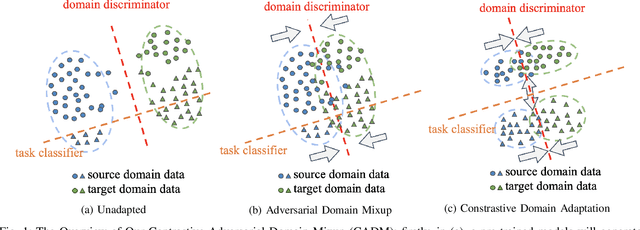

Abstract:In the real-world application of COVID-19 misinformation detection, a fundamental challenge is the lack of the labeled COVID data to enable supervised end-to-end training of the models, especially at the early stage of the pandemic. To address this challenge, we propose an unsupervised domain adaptation framework using contrastive learning and adversarial domain mixup to transfer the knowledge from an existing source data domain to the target COVID-19 data domain. In particular, to bridge the gap between the source domain and the target domain, our method reduces a radial basis function (RBF) based discrepancy between these two domains. Moreover, we leverage the power of domain adversarial examples to establish an intermediate domain mixup, where the latent representations of the input text from both domains could be mixed during the training process. Extensive experiments on multiple real-world datasets suggest that our method can effectively adapt misinformation detection systems to the unseen COVID-19 target domain with significant improvements compared to the state-of-the-art baselines.
Domain Adaptation for Question Answering via Question Classification
Sep 12, 2022



Abstract:Question answering (QA) has demonstrated impressive progress in answering questions from customized domains. Nevertheless, domain adaptation remains one of the most elusive challenges for QA systems, especially when QA systems are trained in a source domain but deployed in a different target domain. In this work, we investigate the potential benefits of question classification for QA domain adaptation. We propose a novel framework: Question Classification for Question Answering (QC4QA). Specifically, a question classifier is adopted to assign question classes to both the source and target data. Then, we perform joint training in a self-supervised fashion via pseudo-labeling. For optimization, inter-domain discrepancy between the source and target domain is reduced via maximum mean discrepancy (MMD) distance. We additionally minimize intra-class discrepancy among QA samples of the same question class for fine-grained adaptation performance. To the best of our knowledge, this is the first work in QA domain adaptation to leverage question classification with self-supervised adaptation. We demonstrate the effectiveness of the proposed QC4QA with consistent improvements against the state-of-the-art baselines on multiple datasets.
Contrastive Domain Adaptation for Early Misinformation Detection: A Case Study on COVID-19
Aug 30, 2022



Abstract:Despite recent progress in improving the performance of misinformation detection systems, classifying misinformation in an unseen domain remains an elusive challenge. To address this issue, a common approach is to introduce a domain critic and encourage domain-invariant input features. However, early misinformation often demonstrates both conditional and label shifts against existing misinformation data (e.g., class imbalance in COVID-19 datasets), rendering such methods less effective for detecting early misinformation. In this paper, we propose contrastive adaptation network for early misinformation detection (CANMD). Specifically, we leverage pseudo labeling to generate high-confidence target examples for joint training with source data. We additionally design a label correction component to estimate and correct the label shifts (i.e., class priors) between the source and target domains. Moreover, a contrastive adaptation loss is integrated in the objective function to reduce the intra-class discrepancy and enlarge the inter-class discrepancy. As such, the adapted model learns corrected class priors and an invariant conditional distribution across both domains for improved estimation of the target data distribution. To demonstrate the effectiveness of the proposed CANMD, we study the case of COVID-19 early misinformation detection and perform extensive experiments using multiple real-world datasets. The results suggest that CANMD can effectively adapt misinformation detection systems to the unseen COVID-19 target domain with significant improvements compared to the state-of-the-art baselines.
Defending Substitution-Based Profile Pollution Attacks on Sequential Recommenders
Jul 19, 2022



Abstract:While sequential recommender systems achieve significant improvements on capturing user dynamics, we argue that sequential recommenders are vulnerable against substitution-based profile pollution attacks. To demonstrate our hypothesis, we propose a substitution-based adversarial attack algorithm, which modifies the input sequence by selecting certain vulnerable elements and substituting them with adversarial items. In both untargeted and targeted attack scenarios, we observe significant performance deterioration using the proposed profile pollution algorithm. Motivated by such observations, we design an efficient adversarial defense method called Dirichlet neighborhood sampling. Specifically, we sample item embeddings from a convex hull constructed by multi-hop neighbors to replace the original items in input sequences. During sampling, a Dirichlet distribution is used to approximate the probability distribution in the neighborhood such that the recommender learns to combat local perturbations. Additionally, we design an adversarial training method tailored for sequential recommender systems. In particular, we represent selected items with one-hot encodings and perform gradient ascent on the encodings to search for the worst case linear combination of item embeddings in training. As such, the embedding function learns robust item representations and the trained recommender is resistant to test-time adversarial examples. Extensive experiments show the effectiveness of both our attack and defense methods, which consistently outperform baselines by a significant margin across model architectures and datasets.
Efficient Localness Transformer for Smart Sensor-Based Energy Disaggregation
Mar 29, 2022



Abstract:Modern smart sensor-based energy management systems leverage non-intrusive load monitoring (NILM) to predict and optimize appliance load distribution in real-time. NILM, or energy disaggregation, refers to the decomposition of electricity usage conditioned on the aggregated power signals (i.e., smart sensor on the main channel). Based on real-time appliance power prediction using sensory technology, energy disaggregation has great potential to increase electricity efficiency and reduce energy expenditure. With the introduction of transformer models, NILM has achieved significant improvements in predicting device power readings. Nevertheless, transformers are less efficient due to O(l^2) complexity w.r.t. sequence length l. Moreover, transformers can fail to capture local signal patterns in sequence-to-point settings due to the lack of inductive bias in local context. In this work, we propose an efficient localness transformer for non-intrusive load monitoring (ELTransformer). Specifically, we leverage normalization functions and switch the order of matrix multiplication to approximate self-attention and reduce computational complexity. Additionally, we introduce localness modeling with sparse local attention heads and relative position encodings to enhance the model capacity in extracting short-term local patterns. To the best of our knowledge, ELTransformer is the first NILM model that addresses computational complexity and localness modeling in NILM. With extensive experiments and quantitative analyses, we demonstrate the efficiency and effectiveness of the the proposed ELTransformer with considerable improvements compared to state-of-the-art baselines.
Talking-head Generation with Rhythmic Head Motion
Jul 16, 2020


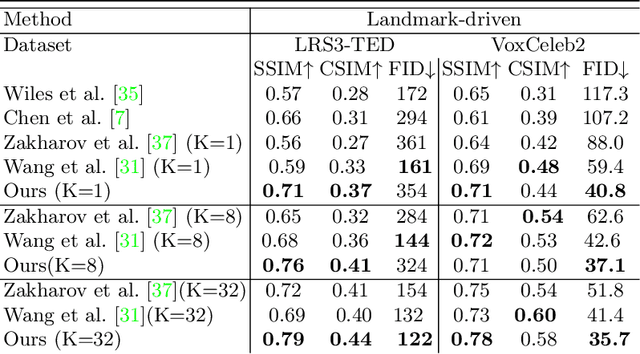
Abstract:When people deliver a speech, they naturally move heads, and this rhythmic head motion conveys prosodic information. However, generating a lip-synced video while moving head naturally is challenging. While remarkably successful, existing works either generate still talkingface videos or rely on landmark/video frames as sparse/dense mapping guidance to generate head movements, which leads to unrealistic or uncontrollable video synthesis. To overcome the limitations, we propose a 3D-aware generative network along with a hybrid embedding module and a non-linear composition module. Through modeling the head motion and facial expressions1 explicitly, manipulating 3D animation carefully, and embedding reference images dynamically, our approach achieves controllable, photo-realistic, and temporally coherent talking-head videos with natural head movements. Thoughtful experiments on several standard benchmarks demonstrate that our method achieves significantly better results than the state-of-the-art methods in both quantitative and qualitative comparisons. The code is available on https://github.com/ lelechen63/Talking-head-Generation-with-Rhythmic-Head-Motion.
STDI-Net: Spatial-Temporal Network with Dynamic Interval Mapping for Bike Sharing Demand Prediction
Jun 07, 2020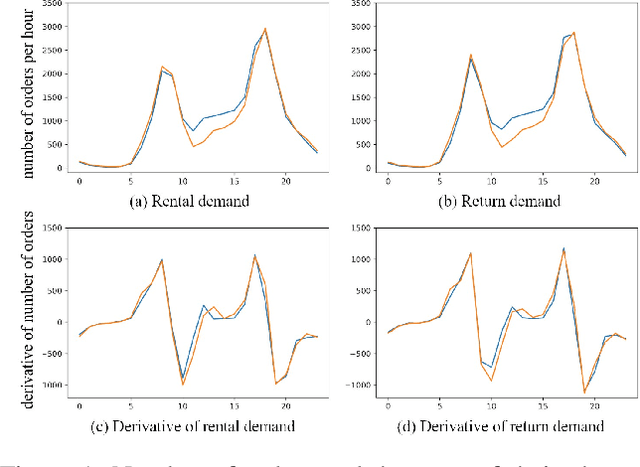
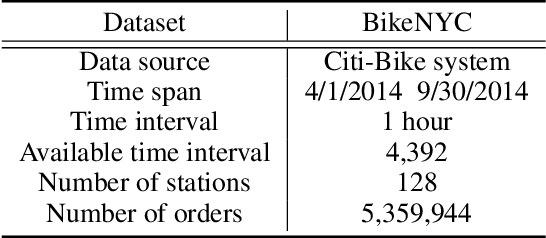
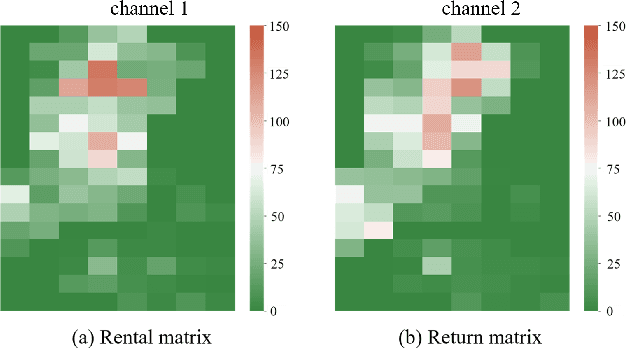
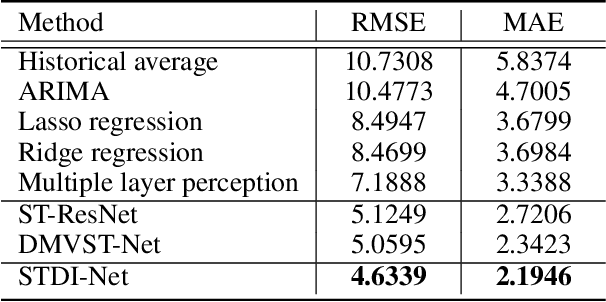
Abstract:As an economical and healthy mode of shared transportation, Bike Sharing System (BSS) develops quickly in many big cities. An accurate prediction method can help BSS schedule resources in advance to meet the demands of users, and definitely improve operating efficiencies of it. However, most of the existing methods for similar tasks just utilize spatial or temporal information independently. Though there are some methods consider both, they only focus on demand prediction in a single location or between location pairs. In this paper, we propose a novel deep learning method called Spatial-Temporal Dynamic Interval Network (STDI-Net). The method predicts the number of renting and returning orders of multiple connected stations in the near future by modeling joint spatial-temporal information. Furthermore, we embed an additional module that generates dynamical learnable mappings for different time intervals, to include the factor that different time intervals have a strong influence on demand prediction in BSS. Extensive experiments are conducted on the NYC Bike dataset, the results demonstrate the superiority of our method over existing methods.
What comprises a good talking-head video generation?: A Survey and Benchmark
May 07, 2020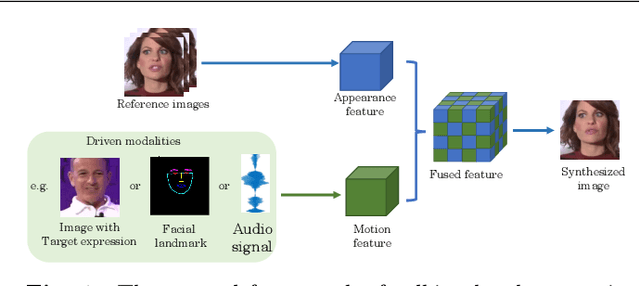
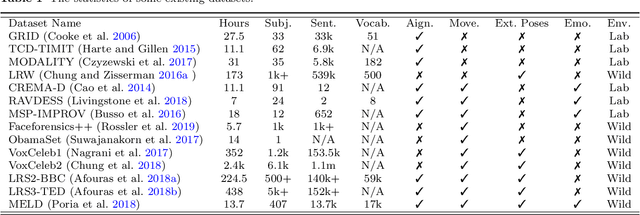
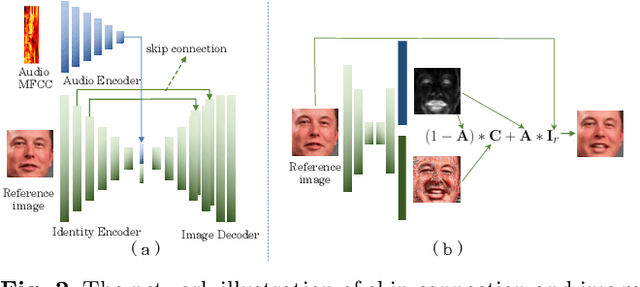

Abstract:Over the years, performance evaluation has become essential in computer vision, enabling tangible progress in many sub-fields. While talking-head video generation has become an emerging research topic, existing evaluations on this topic present many limitations. For example, most approaches use human subjects (e.g., via Amazon MTurk) to evaluate their research claims directly. This subjective evaluation is cumbersome, unreproducible, and may impend the evolution of new research. In this work, we present a carefully-designed benchmark for evaluating talking-head video generation with standardized dataset pre-processing strategies. As for evaluation, we either propose new metrics or select the most appropriate ones to evaluate results in what we consider as desired properties for a good talking-head video, namely, identity preserving, lip synchronization, high video quality, and natural-spontaneous motion. By conducting a thoughtful analysis across several state-of-the-art talking-head generation approaches, we aim to uncover the merits and drawbacks of current methods and point out promising directions for future work. All the evaluation code is available at: https://github.com/lelechen63/talking-head-generation-survey.
 Add to Chrome
Add to Chrome Add to Firefox
Add to Firefox Add to Edge
Add to Edge